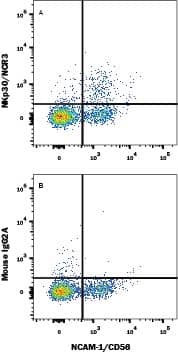Human NKp30/NCR3 Antibody
R&D Systems, part of Bio-Techne | Catalog # MAB1849


Key Product Details
Species Reactivity
Validated:
Cited:
Applications
Validated:
Cited:
Label
Antibody Source
Product Specifications
Immunogen
Specificity
Clonality
Host
Isotype
Endotoxin Level
Scientific Data Images for Human NKp30/NCR3 Antibody
Human NKp30 Antibody Induces IFN‑ gamma Secretion in NK‑92 Cells.
Human NKp30 Monoclonal Antibody induces IFN-gamma secretion in the NK-92 human natural killer lymphoma cell line in a dose-dependent manner, as measured using the Human IFN-gamma DuoSet ELISA Kit (Catalog # DY285B). The ED50 for this effect is typically 0.2-1.2 µg/mL.Detection of NKp30/NCR3 in Human Blood Lymphocytes by Flow Cytometry.
Human peripheral blood lymphocytes were stained with either (A) Mouse Anti-Human NKp30/NCR3 Monoclonal Antibody (Catalog # MAB1849) or (B) Mouse IgG2A Isotype Control (MAB003) followed by anti-Mouse IgG APC-conjugated secondary antibody (F0101B) and Mouse Anti-Human NCAM-1/CD56 PE-conjugated Monoclonal Antibody (FAB2408P). Staining was performed using our Staining Membrane-associated Proteins protocol.Applications for Human NKp30/NCR3 Antibody
Agonist Activity
Sample: NK-92 human natural killer lymphoma cell line
CyTOF-ready
Flow Cytometry
Sample: Human whole blood lymphocytes
Formulation, Preparation, and Storage
Purification
Reconstitution
Formulation
Shipping
Stability & Storage
- 12 months from date of receipt, -20 to -70 °C as supplied.
- 1 month, 2 to 8 °C under sterile conditions after reconstitution.
- 6 months, -20 to -70 °C under sterile conditions after reconstitution.
Background: NKp30/NCR3
NKp30, along with NKp44 and NKp46, constitute a group of receptors termed “Natural Cytotoxicity Receptors” (1). These receptors play a major role in triggering NK‑mediated killing of most tumor cells lines. NKp30 is a type I transmembrane protein having a single extracellular V-like immunoglobulin domain (2). A physical association with the ITAM-bearing accessory protein, CD3 zeta, occurs via a charged residue in the NKp30 transmembrane domain. Ligation of NKp30 with a specific antibody results in phosphorylation of CD3 zeta (3). NKp30 is expressed on both resting and activated NK cells of the CD56dim, CD16+ subset that account for more that 85% of NK cells found in peripheral blood and spleen (4). NKp30 is absent from the CD56bright, CD16- subset that constitutes the majority of NK cells in lymph node and tonsil, however, its expression is up-regulated in these cells upon IL-2 activation (4). Studies with neutralizing antibodies reveal that NKp30 is partially responsible for triggering lytic activity against several tumor cell types and that it is the main receptor responsible for NK‑mediated lysis of immature dendritic cells (2, 5). The ligand(s) recognized by NKp30 has not been described.
References
- Moretta, L. and A. Moretta (2004) EMBO J. 23:255.
- Pende, D. et al. (1999) J. Exp. Med. 190:1505.
- Augugliaro, R. et al. (2003) Eur. J. Immunol. 33:1235.
- Ferlazzo, G. et al. (2004) J. Immunol. 172:1455.
- Ferlazzo, G. et al. (2002) J. Exp. Med. 195:343.
Alternate Names
Gene Symbol
Additional NKp30/NCR3 Products
Product Documents for Human NKp30/NCR3 Antibody
Product Specific Notices for Human NKp30/NCR3 Antibody
For research use only
